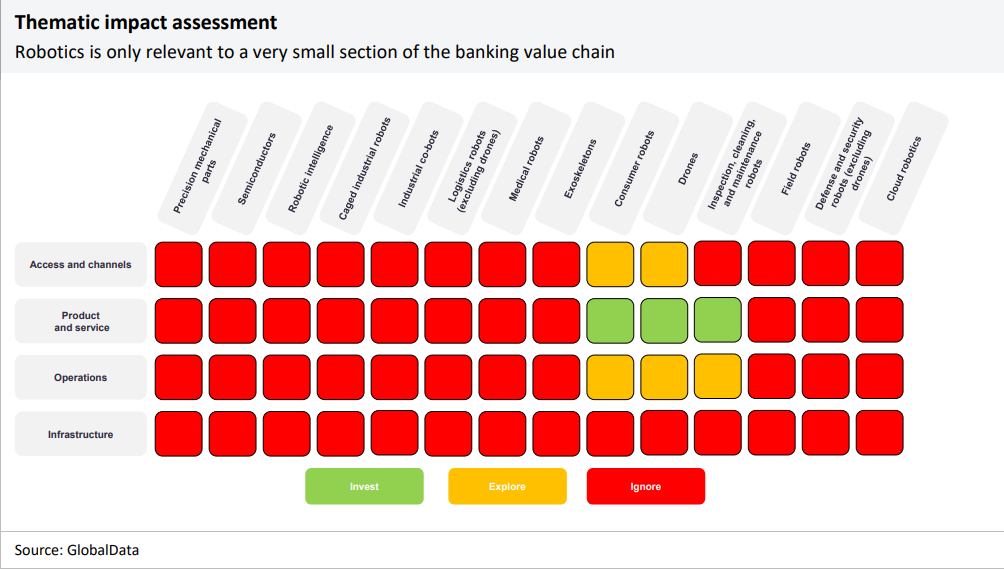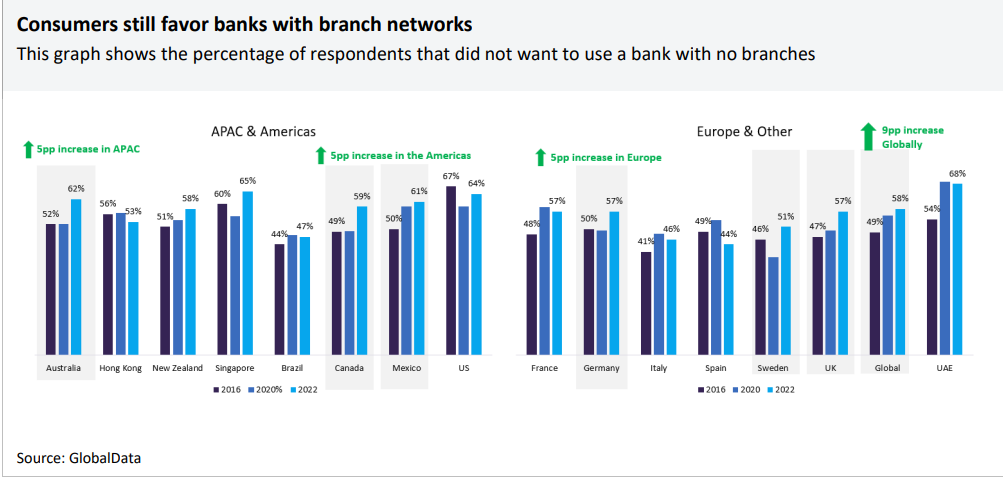Robotics is a fast-growing industry. Although applications in banking are not as mature as in other industries such as defence, construction, or healthcare, it is important to understand how the theme affects the industry, which companies are engaging with it, and what use cases are emerging.
The two areas of robotics in which banks are most interested are consumer robots, in the form of in-branch robots, and drones.
The matrix below details the areas in robotics where banks should focus their time and resources. We suggest banks invest in technologies shaded in green, explore the prospect of investing in technologies shaded in yellow, and ignore areas shaded in red.

How robotics helps resolve the challenge of Covid-19
During the Covid-19 pandemic, branch robots had a slight resurgence as banks tried to make their branches as contactless and automated as possible. DBS and HSBC used robots to allow people to request help without being face-to-face with a human. In some cases, the robots would also help customers ensure they adhered to social distancing rules. They would remind customers to stay 1.5 meters away from each other and ensure they wore masks.
Although these in-branch robots have largely not survived post-pandemic, exploring and investing in this technology could prove helpful for similar events or in the event of a future pandemic. Banks that have explored using these robots will have gathered important consumer data on what does and does not work. This will allow them to develop customer service solutions that respond to customer needs.
The use of drones for surveying before bidding on assets like shipping ports, factories, warehouses, and retail locations to give clients a virtual view, began during the pandemic, will continue post-Covid. It has proven to be a cost-effective and time-saving solution and will be increasingly adopted by banks in the coming years as more and more providers offer 3D mapping services with drones.
How robotics helps resolve the challenge of new pure digital competition
Even the most traditional banks must exhibit their technological prowess to compete with the convenience and appeal of the new digital challenger banks like Monzo and Starling. Implementing robots in branches can signify that some of the most traditional incumbent banks are exploring the latest technological innovations and creating banks of the future.

Although digital competitors are challenging incumbents, customers still value branches. In GlobalData’s 2022 financial services consumer survey, all regions saw a slight increase in favour of banks with branch networks. This indicates that though the functional need for a branch may be declining, customers still appreciate its presence.
Banks need to modernise and automate their branches to stay competitive. Those exploring automated branches and investing in consumer-facing robots are aware of this need for digitalisation. Adapting to new realities in a world of rapid technological innovation is essential for even the most traditional incumbents.
Robotics could also be considered for digital banks, which are aware of this pressure to have a physical presence. For example, digital bank Tyme in South Africa has kiosks manned by one staff member for quick account opening. Here robots could perhaps play a role in welcoming and supporting customers, answering queries, and collecting feedback.
How robotics helps resolve the challenge of personalisation
In this new era of rapid digitalisation, robots could also play a role in maintaining personal relationships with customers. For example, Pepper, the customer service robot used by various banks, could recognise the faces of people entering the bank branch. If the robot connected to the customer database, it would be able to greet the customer, tell them when and where their appointment was, or give them advice based upon the information it had. Although this technology has not been deployed, it could be a vital tool in maintaining personalisation during the shift to digitalisation.
How robotics helps resolve the challenge of cost and revenue pressures
The cost-saving benefits of using drones to conduct flyovers of assets like shipping ports, factories, warehouses, and retail locations is exhibited by banks’ decision to maintain this practice even after social distancing regulations have subsided. It is much quicker and expedites the process of conducting surveys before M&A deals as third parties will no longer need to deploy people to conduct these inspections.
As technology advances further, customer service robots are also potential cost-saving tools for bank branches. These could be a superior option to clerks and bank managers as they could operate 24 hours a day, be deployed anywhere, and be updated immediately without the need for training sessions.
GlobalData, the leading provider of industry intelligence, provided the underlying data, research, and analysis used to produce this article.
GlobalData’s Thematic Intelligence uses proprietary data, research, and analysis to provide a forward-looking perspective on the key themes that will shape the future of the world’s largest industries and the organisations within them.